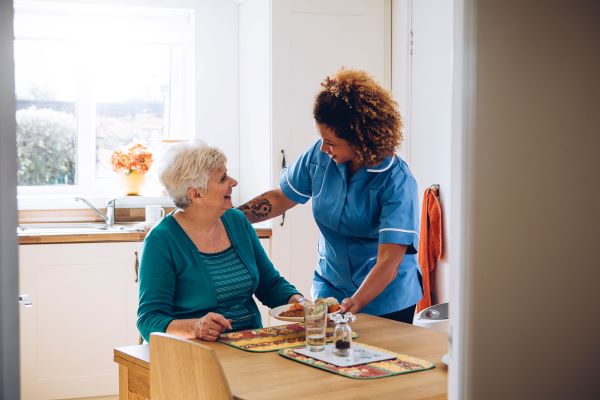Many people mistake dementia symptoms for normal aging. However, memory problems and marked cognitive decline are not considered a normal part of aging and should be assessed by a medical professional.

A Look at the Physical Challenges of Aging in Place
It is estimated that three out of four Americans over the age of 50 plan on aging in place according to AARP. These seniors are willing to employ alternative solutions to make it happen. The alternatives include home sharing (32%), modifying their home (31%), and relocating to communities that provide services that enable aging in place (56%). Senior living communities have become a source of support and engagement for residents and provide a long-term, familiar home environment.
Unpaid Caregivers and Government Assistance
Seniors who want to reside in a community or their own home (age in place) rather than seek residential institutions or nursing homes mostly depend on unpaid caregivers and family members for assistance with activities of daily living (ADL). These activities include laundry, self-care actions like bathing and dressing, meal preparation, and transportation.
Medicaid provides the majority of long-term care services and support (LTSS). However, the LTSS program falls short of the increasing need. While the aging population in America is rapidly growing, more funding is necessary to increase the availability of LTSS for seniors choosing to age in place. The goal of LTSS is to supplement the contribution of unpaid family and caregivers. The addition of Medicare coverage and Medicaid benefits to support family caregivers as they help their loved ones enables more aging adults to successfully remain in their homes.
Caregiver Technology Solutions
Technology has provided some solutions for caregivers, allowing them to monitor their loved one remotely while they stay engaged at work. Smart environmental controls and personal assistants have lightened the load of constant oversight but can’t replace the human touch. Nearly 60 percent of seniors who have seriously compromised mobility report being house or apartment bound, while 25 percent of those seniors say they often remain in bed and don’t dress daily.
Low-tech devices like canes, walkers, ramps, grab bars, shower seats, and raised toilets increase accessibility and safety for aging in place. But transferring in and out of bed and moving around the home is still difficult for many.
Planning is Critical
The senior who wants to age in place focuses on independence and has trouble foreseeing a time when help is necessary. Aging adults and their families need to plan to address changing physical capacities before an adverse health event, such as an unintended fall or dementia, changes everything. While aging in place is a great goal for many seniors, it requires planning just as if they were moving into an assisted living or nursing home facility.
Johns Hopkins researchers report 42 percent of older adults who have problems performing ADLs or are living with probable dementia receive no assistance at all from family, friends, or paid caregivers. That is a staggering number of unaided seniors. Additionally, 21 percent of seniors with a minimum of three chronic conditions and high needs receive no assistance. LTSS, through Medicaid, must meet the ever-increasing demand for human caregiving.
Low-Income Seniors
Affordability for at-home care is a significant issue for seniors and their families. Approximately 60 percent of at-home seniors use at least one low-tech device, most commonly for bathing, toileting, or mobility, throughout their day, but their needs multiply as they age. Medicare Advantage plans, and supplemental benefits cover the expenses of most of these nonmedical devices and services, including wheelchair ramps, grab bars, personal care, and transportation to chronically ill seniors.
Seniors with financial challenges may struggle to pay medical bills or prescription costs, utilities or rent, and some resort to skipping meals to balance out their unaided lifestyle. With the help of elder law attorneys, they can maximize Medicare plans and apply for Medicaid benefits and other government assistance to improve their lifestyles.
Caregivers and assistive low-tech devices are an absolute necessity for seniors opting to age in place. This common strategy requires exploring the best possible solutions and programs to ensure successful aging.
For help with some of the challenges you may face as you age in place, please contact our Cincinnati office at 513-771-2444. We can assist you or a family member with estate planning, elder law, long-term care, and Medicaid planning. We look forward to the opportunity to work with you.



